Everything you wanted to know about coffee but too afraid to ask!

The history of coffee and its origins have been well documented from as far back as 1000AD, from its origins in modern day Ethiopia and its spread to Yemen, Egypt and other parts of the African continent. This, of course, is the bean and plant we know today as Arabica.
It gradually found its way by various means across the oceans to South America and the West Indies over the course of time. Thus, the coffee industry was born.
Nowadays, of course, there are different types of coffee beans and plants and the coffee plant in its various forms have arrived in countries and also a continent better known for its tea production. Coffee has pushed its way eastwards and now at least two of those newcomers on the block are among the top ten coffee producers and exporters in the world.
My aim is to look more closely at four of those countries and explore how coffee has helped and in one case establish the economy of that nation.
To do this we must look at various factors which have shaped the coffee industry in those countries. Some of those factors are natural, some man made and another, to use a more biblical term pestilence.
Firstly, though let us briefly examine the different types of coffee bean and plant and their preferred environment for growth. Then, we can look at what is considered to be the single most influential factor which has determined the future of a country’s coffee industry. This of course is the plant disease commonly called ‘coffee rust’.
There are four types of coffee plant grown commercially throughout the world. We shall look at them in descending order of popularity.
ARABICA
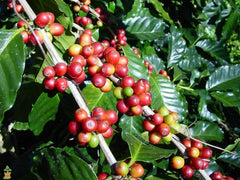
The Arabica plant and bean is considered to produce the best quality of coffee because it has a distinct flavour and aroma. The coffee made from Arabica beans is less acidic than those from other types of beans. An Arabica plant will produce berries two years after transplant and one hectare of land can produce 1000kg of green beans per annum. Care must be taken because this plant is the most susceptible of all the coffee plants to coffee rust disease. It is grown at heights between 900m and 1800m above sea level.
ROBUSTA
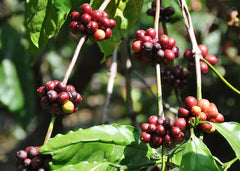
As the name suggests this is a more robust plant and was developed to counter the effects of coffee rust disease. Many coffee plantations changed to this type when their Arabica plants were decimated by the disease. It has a distinct umbrella type growth and produces berries 4 years after transplant. The Robusta berries are blood red in colour when ripe and are closely clustered. It is grown from sea level to a height of 900m above sea level. It can produce 1200kg per hectare per annum. Thus making it popular with small growers since the larger yield can ostensibly provide more income for the farmer. A typical coffee bean blend nowadays can contain 80% Arabica and 20% Robusta.
LIBERICA

As the name suggests this plant originated in Liberia on the West coast of Africa and is also popular with growers in Cameroon and Ivory Coast. It is particularly noted for its strong taste and colour and is drought tolerant. It produces berries 4-5 years after transplant and yields 100kg per hectare per annum. It is grown from sea level to 900m above sea level.
EXCELSA

This plant has smoother and thinner leaves than the other plants and the berries are borne in heavy clusters. This makes it easier for manual harvesting, particularly for the small farmer. It produces berries 4-5 years after transplant and has a yield of 1000kg of green beans per hectare per annum. It is grown from sea level to 900m above sea level.
COFFEE RUST DISEASE
Coffee rust disease is caused by a fungus. It starts off as small, yellow coloured, oily spots which appear on the upper leaf surface of a plant. It then expands into much larger round spots which are bright orange to red in colour. These spots or pustules then turn black and the coffee plant usually dies within a few years. This disease can be treated with fungicide sprays or in some cases moving the plantation to a higher altitude. The fungus which causes this disease finds it harder to reproduce at a higher altitude and, of course, the much cooler air. This disease has been the cause of the destruction of many plantations throughout the world especially in the latter part of the twentieth century. It is a battle which continues to rage but more disease resistant strains of plants have been developed and once this disease was recognised strict quarantine measures and export restrictions of beans from stricken areas has helped greatly to curtail its spread. However vigilance and crop maintenance and early preventative treatment remain imperative to eradicate it.
Throughout history coffee has played its part in the formation of a country’s economy, culture and social life. In some cases it goes back decades, if not, centuries and in other cases it is much more recent. I have selected four countries, each with very different cultures and backgrounds but with one common factor. The role coffee has played and continues to play in each of their economies and what it means to the people of that country.
PHILIPPINES

The coffee industry in the Philippines began in the 1740’s during the Spanish regime of the islands. The Arabica plant was introduced and grown successfully. The coffee produced was for domestic consumption and for export to Spain and its colonies. However, in the latter part of the 19th century, throughout the 1880’s and 1890’s, disaster struck in the shape of coffee rust disease. It spread rapidly through the coffee plantations in the Philippines and virtually destroyed all the Arabica plants on the islands. The coffee industry was decimated and was virtually non- existent.
However, the plantations fought back and newer, more disease resistant plants were imported, planted and eventually the coffee industry was re-established .It has gone from strength to strength from the beginning of the 20th century to the present day. These new plants which were brought in were, of course, Robusta plants. Today, in the Philippines, 85% of coffee beans grown are Robusta with the remaining 15% comprising of Arabica, Liberica and Excelsa.
Nestle became involved in the coffee industry in the Philippines and sought to increase the income of coffee farmers. This was achieved in a variety of ways. Working in conjunction with the Philippines Coffee Board local farmers were given advice on coffee plantation management. This consisted of advice on best ways of weeding, fertilising and pruning the coffee trees in order to achieve the maximum productivity.
Farmers were also encouraged to plant other crops like peppers or pineapples between the rows of coffee trees. This innovation made sure that farmers were not wholly dependent on one crop and could achieve an income all year round. Nestle set up buying stations around the country, where farmers could sell any quantity of beans from 1kg upwards to agents who gave them current market price. This meant that farmers had transportation costs cut since there was a buying station close to them and they no longer had to travel long distances to sell their product.
It is the aim of the Philippines Coffee board and, indeed, the Government to become a net exporter of coffee by the year 2017. With this aim in mind there is active promotion of the planting of new seedlings. The idea behind this is to improve the quality of the beans in order to produce more specialist coffees for export. At the moment, perhaps the best known Philippines specialist coffee is ‘Kape Isla’ or Island Coffee.
A coffee tree grown from a cutting takes a shorter time to mature and start producing beans in a shorter time than those grown from seed. It also yields up to 30% more beans. A coffee tree which has been looked after and maintained properly can survive for 50 years and a farmer can get a crop annually for this length of time.
In the Philippines there is a population of approximately 93million people. The amount of coffee consumed domestically is second only to that of Japan in Asia. Coffee has to be imported from Vietnam and Indonesia to meet this demand. The desire is to increase domestic production to cut down importing coffee and concentrate instead on export.
There is no doubt that the coffee industry in the Philippines has suffered some setbacks. However with determination and some innovative measures this has been overcome and the future of coffee here looks secure and, indeed, is looking to expand.
Now we cast our eyes to a country more famous for tea than coffee. However the coffee industry is alive and kicking and definitely thriving.
INDIA
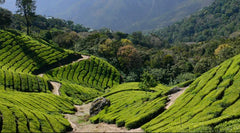
The establishment of the Indian coffee industry is a curious mix of myth, legend and hard fact. When it is put together it makes for interesting reading.
The introduction of the first coffee beans to India is credited to Buba Budan, an Indian Muslim saint. It is said that when on pilgrimage in Yemen, he took seven green coffee beans, wrapped them in a cloth, tied it around his waist and smuggled the beans to Mysore in India. He planted them in the Chandragiri hills and, thus grew the first coffee plants. In those days it was a crime to smuggle any coffee plant or green bean out of Yemen. However the number seven is considered to be a sacred and sacrosanct number in the Muslim faith. So instead of this being looke upon as a crime, it was considered to be a religious act. We do not have a definitive time line for this act but was probably sometime in the 13th or 14th century.
More systematic planting, however, did not begin until the 1670’s.When colonialism came to India in the 1840’s it was the British who established the first plantations. These were in the south of India, where the coffee industry is still located today. These first coffee beans were for export, mainly to Britain and the rest of her colonies. However, as had happened in the Philippines the original Arabica plants were hit by an infestation of coffee rust disease and were almost totally wiped out. These, however were replaced by the new Robusta strain of plant and today the Robusta is the most common variety of coffee grown in India.
Coffee growing in India is concentrated mainly in the hill regions of the South Indian states. The state of Kamataka accounts for 53% of production, the state of Kerala 28% and the state of Tamil Nadue 11%. The balance is taken up by Andhra Pradish and Orissa on the eastern coast of India. A third region in the north-east of the country consisting of the states of Assam, Manipur, Meghlaya, Mizoram, Tripura, Nagaland and Arunachal Pradesh. These states are more popularly known in India as ‘Seven Sister States of India’. Indian coffee is mainly grown in monsoon regions of the country, and indeed, it is more popularly termed throughout the world as ‘Indian Monsoon Coffee’.
In the 1870’s however coffee production declined quite sharply and it became massively overshadowed by the tea industry. In fact many coffee plantations were replaced by tea plantations, especially when the dreaded coffee rust disease took hold. Despite this however India remained one of the mainstays of coffee production in the British Empire. In fact in the years 1910 until 1912 the area under coffee production in the Southern states of India was put at 203, 134acres. The majority of this produce was exported to Britain.
Inevitably British rule in India came to an end and this had an effect on the economy of the country. In 1942 the Indian Government decided that in order to protect the interests of the small and marginal farmers it would regulate the export of coffee. The government passed an act called the Coffee VII Act of 1942. Under the auspices of this act the Coffee Board of India was set up and was operated by the Ministry of Commerce and Industry.
In order to control the coffee which was exported the beans from all coffee growers in India were pooled and each grower received the same amount of money for their beans regardless of the quality. This had a detrimental effect because growers had no incentive to improve the quality of their beans. This ensured that the quality of coffee produced in India became stagnant. Despite this however coffee bean production continued to grow.
From the beginning of the 1970’s until the start of the next decade coffee production almost doubled from 68, 948 tons to 120, 000 tons. Production rose by an average of 4.6% through the 1980’s but rose by a massive 30% in the 1990’s. This rise was due to an upsurge in the whole of the Indian economy and several things happened in successive years which greatl benefited coffee growers.
The Indian Government had set an Internal Sales Quota which meant that all growers had to sell 30% of their produce domestically. This was amended in 1994 by a Free Sale Quota which allowed all coffee growers to sell between 70% and 100% of their product either domestically or internationally. This was further amended two years later in 1996 and allowed all growers to sell their product wherever they wished. This greatly freed up the coffee industry to grow and sell whatever they wished to whomever they wished.
By 2007 organic coffee was grown over 6, 400 acres in India and this alone produced 1700 tons annually. In 2008 further figures were released by the Food and Agricultural Organisation. These figures showed that a total of 850, 000 acres of land were dedicated to the growing of coffee, with an estimated production of 262, 000 tons annually.
There are 250, 000 coffee growers in India, 98% of whom are termed as small growers. Around 90% are farms consisting of 10 acres or less. Figures released in 2009 showed that coffee produced in India accounted for 4.5% of the total world production. Of the coffee produced in India 80% is exported. Italy accounts for 29% of that on its own whilst the remainder is exported to countries as diverse as USA, Russian Federation, Japan, Greece and Slovenia.
Until 1995 the Coffee Board of India marketed the coffee of Indian growers from a pooled supply of beans. This has now been privatised and the quality of coffee has improved greatly. The Coffee Board still provides help to small growers either with technical advice or financially. It also helps to safeguard working conditions for those within the coffee industry and also manages a pool of any unsold coffee.
There are coffee shops throughout India, mainly in the south. The coffee Board started them in the 1940’s but this changed in the 1950’s when they were taken over by a worker’s co-operative.it opened its first coffee house in New Delhi in October of 1957. These quickly expanded and branches appeared in cities all over the country. Today the largest coffee bar chain in India is Café Coffee Day. However domestic consumption of coffee in India is greater in the south of the country than anywhere else.
Now we can look at a country whose whole way of life was torn apart and a whole nation's world changed, not just its coffee industry. That country is Vietnam.
VIETNAM
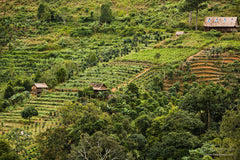
Coffee was introduced to Vietnam in 1857 by the French. Vietnam was colonised by them as part if what was known as Indo-China. Production at this time was very small scale with the coffee being produced for mainly local consumption by the French colonists. However, as we moved into the 20th-century production began to move up a gear and large coffee plantations were established. The coffee industry was centred mainly in the Buon Ma Thuot region of Vietnam.
However, coffee production was rudely interrupted by the outbreak of war between the pro-communist forces of the North and the eventually American backed forces of the South. Although the Buon Ma Thuot region itself was not at the centre of the conflict it was a crossroads between the North and the South. The area became largely de-populated and production of coffee virtually ceased.
After the war the coffee plantations were collectivised and private enterprise was discouraged. This led to very low production levels. However this changed in 1986 when the Government introduced economic reforms throughout Vietnam and private enterprise was encouraged in the production of commodity goods like coffee.
This led to a greater co-operation between the growers and the government. As a result production increased dramatically as did the quality of the beans. This resulted in better quality branded coffees being produced and Vietnam was able to start exporting their coffee. By the year 2000 production had grown to 900, 000 tons annually. By 2009 this had grown to a reported 1.13 million tons and Vietnam became second only to Brazil as the leading exporter of green coffee beans in the world.
The type of coffee grown commercially in Vietnam is 97% Robusta. However, the introduction of Arabica has led to the production of mixed bean coffee as well. Vietnam has attempted to break into the specialist coffee market but their version of Kopi Lowak known as ‘Weasel coffee’ is popular in Vietnam but its taste is chemically simulated and most definitely not the real thing.
One area in which Vietnam has excelled is the production and export of instant coffee. In 1969 the Coronel Coffee Plant was built in 1969 by a French engineer called Marcel Coronel. The aim was to produce an inexpensive instant coffee for export mainly to France. However, the Vietnam war put paid to these plans and Coronel left Vietnam in 1975 at the end of the war. The Provisional Revolutionary Government of Vietnam took over the running of the plant and in 1977 the first batch of instant coffee was processed.
The following year Vietnam joined Comecon and this enabled them to export to the Soviet Union and the Soviet Bloc states. In 1983 the Vinacafe brand was established. This was the name that their instant coffee sold under. However, in 1991 Comecon was disbanded and the Vietnamese had to look for new international markets.
In 1993 Vinacafe introduced its ‘3-in-1’ coffee. This was an instant coffee which also contained non-dairy whitener and sweetener. This proved very successful and today the ‘3-in-1’ brand has been registered as a trademark in over 60 countries worldwide.
To meet with demand a second coffee plant was built next to the original one and became operational in 2000. It has a designed capacity of 800 tons per annum. However, a third plant was built nearby to cope with the ever-increasing demand. It has a designed output of 3, 200 tons per annum and came into production in 2012. Up to 70% of all the production from those three plants will be exported.
Vietnam is looking to boost its presence in the Chinese market by the first quarter of 2013. It is looking to open a new plant in China’s northern Area. The Chinese market accounts for 30% of Vincafe’s export value. This is second only to the US market at 35%.
Vietnam’s story is a bit of a rags-to-riches theme to it but there is no doubting the importance of coffee to this country’s economy. In fact, coffee is second only to rice in the agriculture products field exported from Vietnam.
This brings us nicely to a country virtually unknown for coffee production or consumption.
CHINA
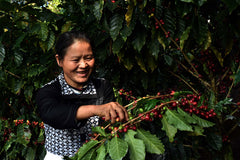
China is a land of mystery to many people and not only to Westerners. For a long time coffee production was something known only to a few select people both inside China itself and of course in other countries.
Arabica coffee was introduced to the Yunnan Province of China around 1880 by French missionaries. They came into China from its borders with Laos, Vietnam and Burma. They started growing it in the foothills of the Himalayas which was ideal for coffee. The result was an excellent quality Arabica coffee. However it was not really to the locals taste and was produced only for personal consumption.
There are three types of bean produced in the Yunnan Province. These are:-
AA YUNNAN HIGHLAND BLEND ARABICA 100% Arabica made up from beans from the three different regions in Yunnan.
AA YUNNAN SINGLE HIGHLAND ARABICA 100% Arabica from the highest and finest region in Yunnan.
AAA PEABERRY YUNNAN HIGHLAND ARABICA 5% grown is classed as peaberry beans and grows in the highest region of Yunnan.
In China, the coffee industry is overshadowed by the tea industry. However, in 2008 this started to change when the price of tea collapsed. For the first time, ever farmers were encouraged to switch to coffee production and tracts of hillsides were cleared to allow more coffee production. In January of 2012 one region in Yunnan had 70, 000 acres under coffee production. This was twice as much as 2009 and it is expected to grow by half again by 2015. Growth in tea production remained static during this time. To put this into perspective a family cultivating 1 hectare of coffee can expect to earn $ 10,000 annually. This is three times the amount they would earn if they grew tea and five times more than if they grew maize or rice. The financial incentive is certainly there to grow coffee.
This upsurge in the popularity of coffee is due in part to western influences. Young people, especially in the large cities, see it as being more exciting and sophisticated and more American to drink coffee than tea. Starbucks has been in China for 12 years now and has 1200 outlets throughout the country. McDonalds and KFC also sell coffee at their outlets so it is becoming more readily available.
In 2011 coffee consumption grew by 9% and it is confidently predicted it will continue to grow at that level for the foreseeable future. Starbucks recently announced its intention to grow its own coffee. Not only for domestic use in China but for export.
To put this growth in perspective, Starbucks announced in 2011 that it opened an outlet on average one every four days. McDonald's even more recently announced its intention to open an outlet every day in China for the next 3 or 4 years. Many of these outlets will have a separate McCafe selling coffee.
Coffee drinking in China is seen as a mainly middle-class urban phenomenon centred around the 20 to 40 age group. The younger people drink coca-cola whilst older people continue to drink tea.
Whatever the reason there can be no doubt that coffee consumption in China is rising and seems set to continue this trend. By 2015 Starbucks estimate that China will surpass Canada as their biggest market outside of the US.
It has been shown how important coffee production is for some countries. In particular, those countries not blessed with vast reserves of oil and gas and natural minerals. It is estimated that coffee production is second only to the oil and gas industries in the world in terms of the amount of revenue it generates.
The next time you raise a cup of coffee to your lips give a thought to the incredible journey the coffee bean has made. It started from humble beginnings in Ethiopia and is now grown in every corner of the world. It is arguably the world’s favourite beverage.
-By Graeme Berry (Discount Coffee Team Member)



 All Cups
All Cups Black Ripple
Black Ripple Compostable Kraft
Compostable Kraft Premium Ripple
Premium Ripple  Double Wall
Double Wall White Single Wall
White Single Wall Smoothie Cups
Smoothie Cups Bubble Tea Cups
Bubble Tea Cups Seasonal Cups
Seasonal Cups Water Cups
Water Cups Cups & Lids Pack
Cups & Lids Pack  Lids
Lids Straws
Straws Cup Carry Trays
Cup Carry Trays Stirrers
Stirrers  Wooden Cutlery
Wooden Cutlery Food Containers
Food Containers Salad Containers
Salad Containers Rio Coffee
Rio Coffee Rio Vending
Rio Vending Torro
Torro Good Calories
Good Calories Mokate
Mokate Scottish Roast
Scottish Roast Monin
Monin Simply Syrups
Simply Syrups Border Biscuits
Border Biscuits Larozza
Larozza All Brands
All Brands